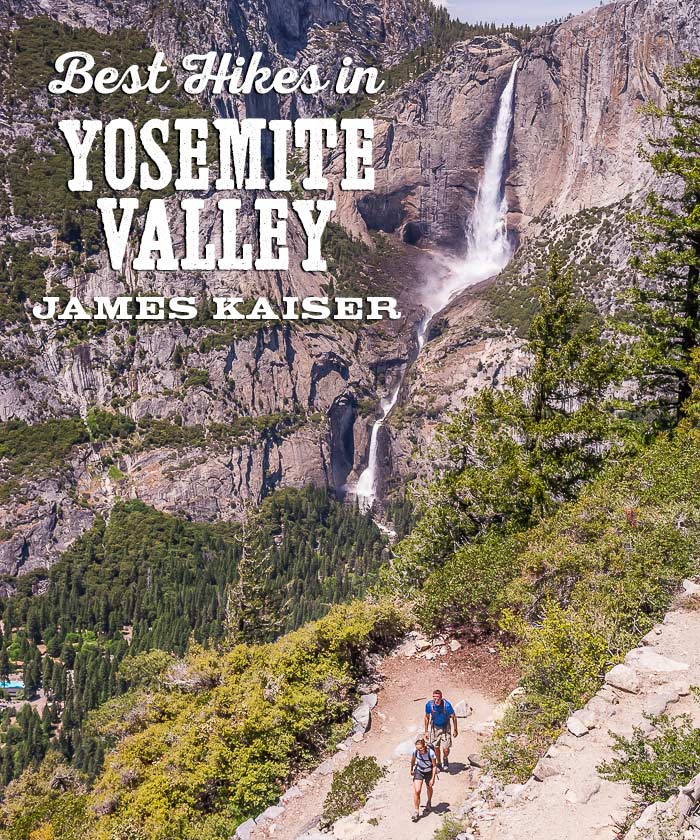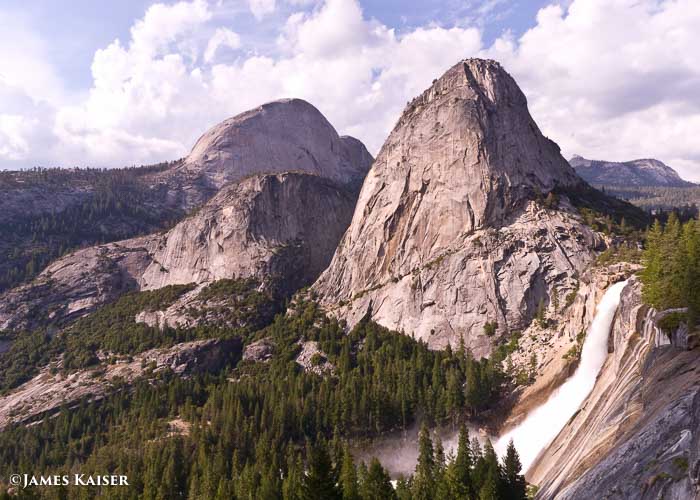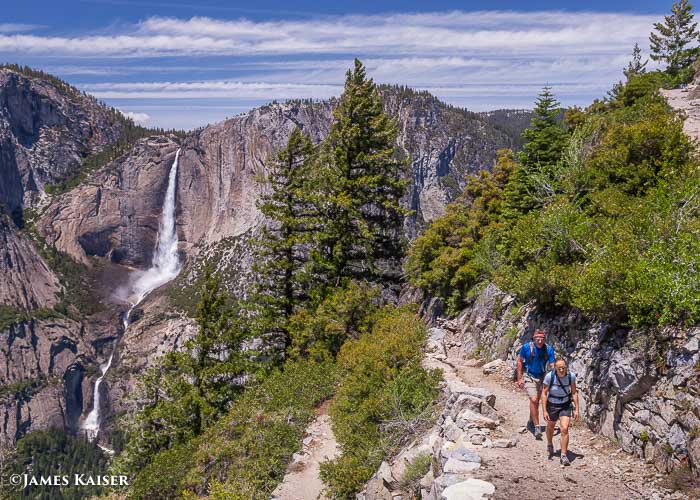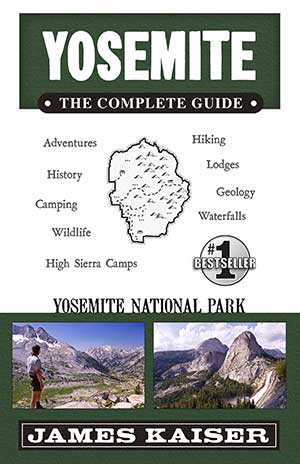
Hiking is one of the best ways to experience Yosemite Valley. Millions of tourists enjoy the views from roadside pullouts, but the great hikes that rise above Yosemite Valley reveal some of the best views in Yosemite National Park.
May and June are the best months for hiking in Yosemite Valley. In late spring Yosemite’s famous waterfalls are near their peak, the dogwoods are in bloom, and temperatures are perfect for hiking.
By July and August, the waterfalls have slowed to a trickle. Summer temperatures are hot, and Yosemite Valley is filled with tourists. (This is a great time to visit Tuolumne Meadows!) It won’t be until mid-September that the crowds thin out and the temperatures cool off.
Although it’s possible to hike from November through April, winter is cold and snowy in Yosemite National Park.
No matter when you visit Yosemite Valley, hiking is one of the best ways to avoid the crowds. Most visitors never venture more than a few feet from their cars. Hiking sets you apart from the 95% of park visitors. Except for the ultra-popular Mist Trail, crowds drop off exponentially for each vertical foot you climb.
Best Hikes in Yosemite Valley

Half Dome
Difficulty: Very Strenuous
Distance: 17 miles, round-trip
Hiking Time: 12–14 hours
Elevation Change: 4,800 feet
Half Dome is, without question, the most famous hike in Yosemite National Park. This towering quirk of geology beckons every adventurer who sets eyes on it.
The challenging 8.5-mile trail to the summit starts in Yosemite Valley. The trail passes by two waterfalls—Vernal Fall and Nevada Fall—then climbs to the base of Half Dome’s steep backside. From there you’ll haul yourself up a pair of metal cables drilled into the rock. Climbing Half Dome’s cables is a vertigo-inducing experience sure to quicken any pulse!
Make no mistake, Half Dome is not for the faint of heart. But if you’ve got the physical and mental stamina to hike Half Dome, you’ll be rewarded with jaw-dropping views of Yosemite Valley. It’s an experience you’ll never forget.
Strong hikers can make it to the top of Half Dome and back in 12 hours. If you decide to hike Half Dome in two days, you must obtain wilderness permits. You’ll camp at Little Yosemite Valley Campground, located about halfway to the top of Half Dome.
Trailhead The most popular route to the top of Half Dome starts in Happy Isles (shuttle stop #16) and follows the Mist Trail to the top of Nevada Fall. From there follow the signs to the top of Half Dome.
See also: Hiking Half Dome – The Definitive Guide

Mist Trail
Difficulty: Strenuous
Distance: 3 miles, round-trip
Hiking Time: 3–4 hours
Elevation Change: 1,000 feet
The Mist Trail is the most popular trail in Yosemite, and with good reason. Although relatively short by Yosemite standards, it passes by some of the park’s most dramatic scenery. The Mist Trail skirts the boulder-strewn banks of the Merced River and then heads up a series of stone steps in front of 317-foot Vernal Fall. In the spring and early summer, the thundering waterfall soaks hikers in a drenching, rainbow-filled spray. (Beware of slippery stone steps!) The only downside of the Mist Trail: massive crowds throughout the summer. On busy weekends, this hyper-popular trail can feel more like a trip to the mall than the Great Outdoors.
Trailhead: The Mist Trail starts in Happy Isles (shuttle stop #16) at the far eastern end of Yosemite Valley. From the shuttle stop, cross the stone bridge and follow the well-trodden path to your left.

Nevada Fall
Difficulty: Strenuous
Distance: 7 miles, round-trip
Hiking Time: 4–5 hours
Elevation Change: 1,900 feet
If hiking the Mist Trail to the top of Vernal Fall leaves you hungry for more, continue an additional 1.2 miles to the top of 594-foot Nevada Fall. This steep trail has significantly fewer hikers than the Mist Trail, and the views from the top are spectacular. For a bit of scenic variation on your return, loop back along the John Muir Trail.

Yosemite Falls
Difficulty: Strenuous
Distance: 7.6 miles, round-trip
Hiking Time: 4–5 hours
Elevation Change: 2,600 feet
If you love 2,400-foot waterfalls and strenuous hikes, it doesn’t get better than this. You’ll pant and sweat all the way to the top, but there’s no better way to revel in the majesty of Yosemite Falls. After climbing the trail’s 135 switchbacks, you’ll be treated to sweeping views of Yosemite Valley and amazing glimpses of Upper Yosemite Fall. The top of the trail follows a notch in the cliff that brings you above the waterfall, and from there a narrow path drops down to a fenced-in ledge beside the lip of Upper Yosemite Fall. If you’re afraid of heights, the fenced-in ledge is probably not for you. But if you like dramatic views, it’s well worth the effort. If you don’t feel like climbing all the way to the top, Columbia Point (1.2 miles from the trailhead, 1,000-foot elevation change, 80+ switchbacks) is a great destination with sweeping views of the Valley.
Trailhead: The trail to the top of Yosemite Falls starts at Camp 4. Take the shuttle to Yosemite Lodge (stop #7), and cross the street to Camp 4. The hike starts between the parking area and the campground.

Four Mile Trail
Difficulty: Strenuous
Distance: 9.2 miles, round-trip
Hiking Time: 5–7 hours
Elevation Change: 3,200 feet
Millions of tourists drive to Glacier Point to check out the stunning views, but those views are even more rewarding when you’ve earned them via the Four Mile Trail. This is one of the best hikes in Yosemite Valley, with unrivaled views of Yosemite Falls. If hiking 3,200 feet up isn’t your thing, try riding the bus to Glacier Point and hiking 3,200 feet down to Yosemite Valley. Conversely, if hiking just 9.2 miles isn’t your thing, consider the following 11.5-mile hike: head up the Four Mile Trail, then hike 4.4 miles down the Panorama Trail to the top of Nevada Fall, then hike 2.5 miles down to Yosemite Valley via the Mist Trail. If you’ve got the time and the energy, the Four Mile Trail >> Panorama Trail >> Mist Trail route is one of the finest in the park.
Trivia: Why is it called the Four Mile Trail when it measures 4.6-miles long? Because the original trail, which was built in the 1870s by James McCauley, was exactly four miles long.
Trailhead The Four Mile Trail starts between Sentinel Beach and Swinging Bridge on Southside Drive.

